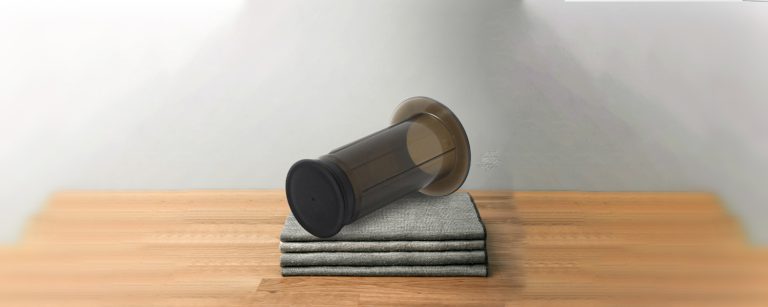In-Depth Chemex Review: My Brewing Experience & Coffee Quality
Being a barista, I’ve seen and tried my fair share of brewing methods. But there’s one that has always captivated my attention with its elegance and simplicity: the Chemex Coffee Maker.
If you’re curious about what makes this glass masterpiece so alluring and how it compares to other brewing techniques, grab your favorite mug, settle in, and let me share my thoughts with you in this complete review of the Chemex drip coffee maker.
It might just redefine your morning ritual.
What is a Chemex?
A Chemex is a manual pour-over coffee brewer, known for its hourglass design made from high-quality borosilicate glass. It combines style and functionality, using unique, thick filters to produce smooth, clean-tasting coffee that highlights the beans’ natural flavors.
Brief History of the Chemex Coffee Maker
The Chemex was invented back in 1941 by Dr. Peter Schlumbohm – a chemist who held over 300 patents throughout his lifetime. He applied his scientific knowledge of chemistry and filtration to create this unique brewing method.
The result? A pure, clean cup of coffee that accentuates every nuance of the flavor of coffee beans.
What I think really sets it apart from other brewers is its marriage between form and function.
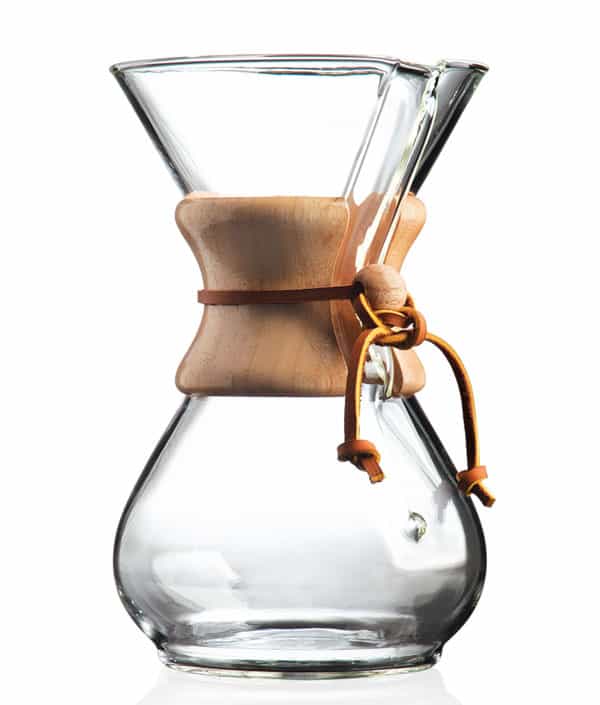
I think you’ll agree with me that it beautifully combines elegant design with practical utility. As such, many consider it not only a coffee-making tool but also a work of art — a sentiment echoed by its inclusion in the Museum of Modern Art’s permanent collection since 1943.
Chemex In Popular Culture
Over time, the striking look and high brewing quality of the Chemex have earned it not just a place in our kitchens, but on our screens as well.
Its unmistakable shape has graced TV shows like Friends, Mad Men, and movies like Rosemary’s Baby, and James Bond — adding an air of sophistication whenever it appears on screen.
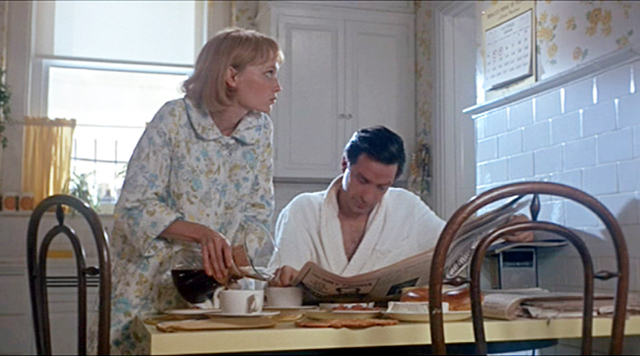

I also love reading the mentions of Chemex across social media platforms, where coffee nerds showcase their love for this iconic brewer.
Features of the Chemex Coffee Maker
Let’s continue to explore the world of this iconic brewer from a more practical perspective.

Pros
Cons
Design and aesthetics
Most people find the hourglass-shaped glass body combines simplicity with sophistication, making the Chemex not only functional but also an elegant piece to display in any kitchen or café.
The wooden collar and leather tie that holds it in place adds elegance to its aesthetic appeal. I mean who wouldn’t want to showcase a museum exhibit at home 🙂
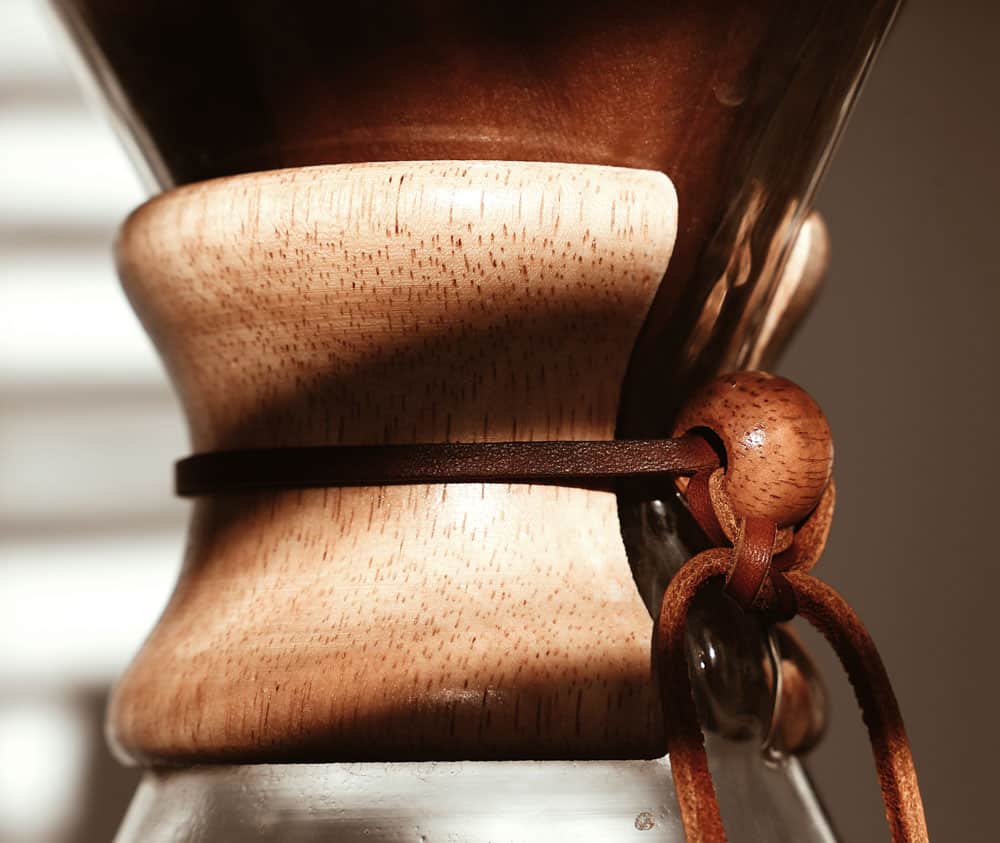
Different sizes and variations (Classic, Handblown, Glass Handle)
The Chemex comes in several sizes ranging from 3-cup to 13-cup models amongst all of its models:
- Classic Series – the original model
- Handblown Series – the same body, but made by hand
- Glass handle series – has a glass handle instead of the signature wooden collar

Personally, I find the Handblown Series adds an artisanal touch to the essence of the brewer. It costs a bit more, but knowing that is was hand made is worth it for me.
Materials used (non-porous borosilicate glass)
One key element which sets the Chemex apart is its use of non-porous borosilicate glass. This material ensures that there are no unwanted odors or chemical residues affecting the brew’s flavor, which is important for a consistently delicious cup of coffee.
The iconic wooden collar and leather tie on the classic Chemex have the functional purpose of keeping your hand away from the hot glass as you pour your coffee. Aesthetics paired with functionality.
Types of filters available for Chemex (paper, metal) and their impact on flavor
Regarding Chemex filtering options, you have 3 choices:
- paper
- metal
- cloth
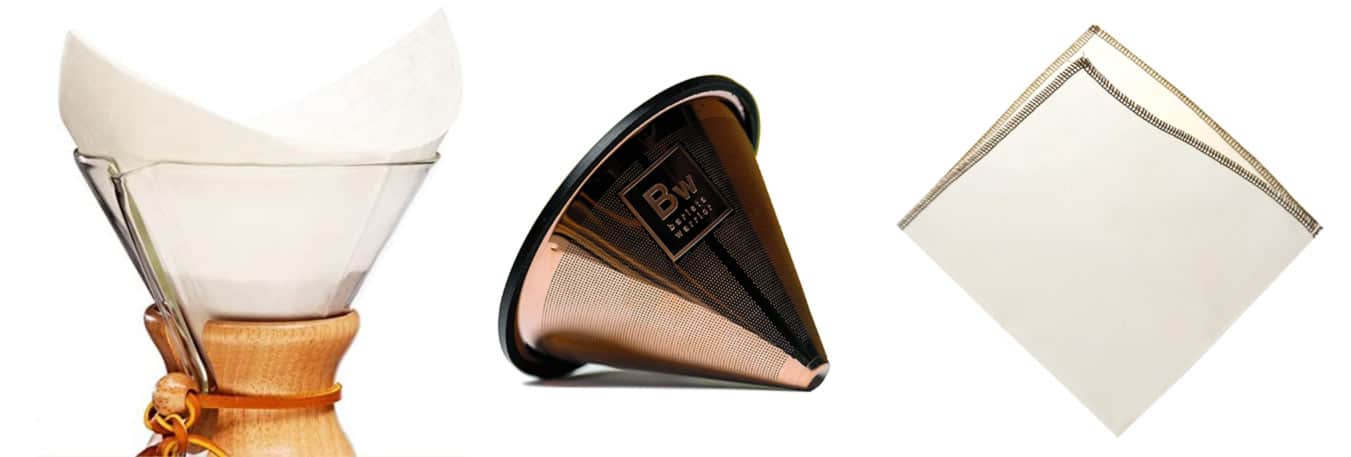
As someone who has experimented extensively with both types, I lean towards using Chemex’s proprietary bonded paper filters, which allow fewer coffee oils and residues through than metal filters. This results in a cleaner-looking and tasting cup with less sediment, while still retaining all those flavors we love about our favorite beans.
Chemex paper filters are the only coffee filters that require a bit of folding on the user’s part, but it’s not hard. Here is a guide on folding them.
What does Chemex coffee taste like?
Ah, this is where things get interesting! A well-brewed cup of Chemex coffee tends to be bright and clean-tasting – perfect if you enjoy exploring delicate nuances within different roasts and origins. Many people describe the taste as “smooth” and “pure,” thanks to how efficiently the brewing process can extract coffee flavors without over-extracting.
As a barista, I find this makes Chemex an ideal choice for those wanting to experiment with various beans in search of the “perfect cup”. Using it has allowed me to fully appreciate the complexities and intricacies of each type of coffee bean. The brew often highlights fruity and floral notes that other methods might mask, providing a truly unique drinking experience.
If you’re someone who values quality over quantity, I believe the Chemex is an excellent investment in your daily coffee routine.
Brewing Process and Cleaning. Is it worth the hassle?
Brewing coffee with a Chemex is an intricate process that requires attention to detail, but once you get the hang of it, trust me, you’ll never want to go back. It’s not quick, but if you have the time, it is something that I find very enjoyable and satisfying.
Here is a detailed guide on how to brew with the Chemex, but in short, these are the steps:
- Weigh your coffee beans, aiming for about 15-18 grams per 8 ounces of water.
- Grind size: aim for a medium-coarse ground coffee – similar in texture to kosher salt or coarse sugar.
- Boil your water to around 200°F (93°C), which is the ideal range for extracting all of the flavors from your grounds.
- Grab a paper filter, place it into the carafe, and wet it gently to help remove any residual papery taste, warm the carafe, as well as stick it nicely in position. Discard the rinsing water.
- Pour your fresh coffee grounds into the filter, making sure it’s evenly spread out.
- Now comes one of my favorite parts – the 30-second bloom. This is when you would start your stopwatch and tare your coffee scale, and gently pour just enough hot water over the grounds to saturate them completely (this equals to about 2x the weight of the coffee grinds). This will initiate flavor extraction as CO2 gases escape.
- After letting it bloom, continue pouring more hot water in small circular motions across the surface without touching the edges too much.
What kind of beans should you use?
As for recommended beans, I personally love using light to medium-roasted single-origin coffees like these when brewing with my Chemex – it allows each unique varietal to shine through without being overshadowed by heavy roasts or blends.
Cleaning your Chemex properly is vital for flavor consistency between brews. The easiest method I’ve found to clean it is to simply rinse the carafe with warm water and a soft sponge or dedicated cleaning brush shortly after use. This helps remove any residual coffee oils and prevents them from building up over time, all in an effort to keep it looking like the pristine work of art that it is.
In terms of longevity and potential issues, proper care goes a long way in maintaining the life of your Chemex. Unfortunately, due to its glass construction, it may sometimes suffer from inevitable accidents (I’ve had my fair share as well), but generally speaking, these beauties are quite sturdy when handled with respect. You don’t want to be taking them on the road though, they are not suitable as travel coffee brewers like the Aeropress Go.
So is it worth the hassle?
As you can see, brewing with a Chemex is a bit more involving than just pressing the On button on a drip coffee maker, but the results are not even comparable. A bright and clear cup like no other.
Before You Buy a Chemex: Is it right for you?
Before you dive headfirst into buying a Chemex, there are a few factors to consider. Trust me; I’ve seen people make the mistake of jumping in without considering their coffee preferences and brewing habits before.
To save you from making the same mistake, let’s take a closer look at some key considerations.
Your Coffee Preferences
First things first – what kind of coffee do you enjoy? If you’re after strong and robust flavors, then this device may not be for you. It produces a clean, bright cup with subtle notes – perfect for those who appreciate lighter roast coffees or want to experience the true flavor profiles of their beans.
If you like strong coffee like espresso, you probably should not get a Chemex.
Amount of Coffee You Brew At Once
The size of your household should determine what size Chemex would serve best:
- A 3-cup capacity model is ideal if you’re living solo,
- An 8-cup one works well for couples or small groups.
- For families or larger households, go for the bigger sizes or brew multiple batches simultaneously.
Time and Effort
Brewing with a Chemex requires time, effort, and patience compared to other easier-to-use brewing methods like drip machines that automate most processes.
However, this added work rewards you with more control over every aspect of your coffee-making experience- grind consistency, water temperature, extraction rate etc., which ultimately leads to better-tasting coffee.
If you are the type to enjoy finicking over the details in order to drink great coffee, you’re good to go.
If you want the ease of pushing a button, look at automatic drip machines like the Breville Precision Brewer instead.
Chemex vs. Competitors: A Comparison
If you’re searching for a quality drip brewer, chances are high that you’ve encountered the Hario V60 and Kalita Wave as top options alongside Chemex. All three use pour-over brewing methods to extract coffee from your grounds, but each has unique features that cater to different preferences.
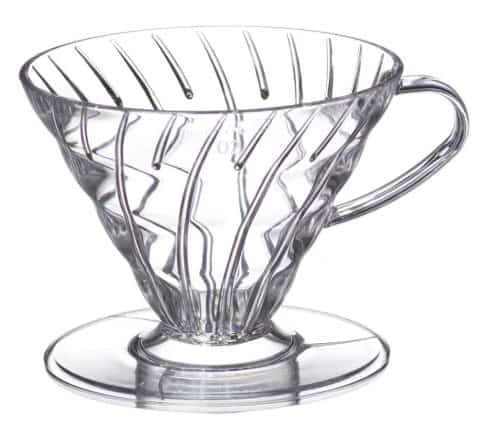
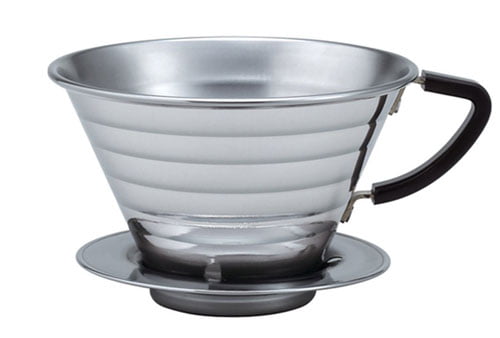
The grind size plays a significant role in brewing with these devices. The Chemex requires a medium-coarse grind, whereas the Hario V60 is more versatile, adjusting the strength of the coffee based on grind size and pouring speed. The Kalita Wave works best with a finer grind close to table salt consistency.
Regarding funnel design, the Hario V60 has angled ridges inside its cone, which allows brewed coffee to flow down smoothly through the sides of the filter. The Chemex lacks these ridges, so most of the brewed coffee exits through the bottom of the funnel.
Paper filters greatly influence each brewer’s output. Chemex uses thicker filters that remove all sediments and oils for the cleanest cup of the 3 brewers, while both V60 and Kalita Wave use thinner filters.
Size-wise, the Kalita Wave and Hario V60 prepare one or two cups at a time, while Chemex offers models of different sizes from 3 to 13 cups.
Lastly, materials differ as well – Chemex is made from durable borosilicate glass, which is perfect for home use, but I would not recommend it for traveling. Kalita Wave comes in stainless steel, and the Hario comes in all kinds of materials, making them lightweight and better suited for camping trips or any other form of traveling.
| Feature | Chemex | Hario V60 | Kalita Wave |
|---|---|---|---|
| Grind Size | Medium-coarse | Versatile (Fine to medium) | Fine (Table salt consistency) |
| Funnel Design | No ridges | Curved ridges | Flat bottom with ridges |
| Filter Thickness | Thicker | Thinner | Thinner |
| Brew Clarity | High (No sediment/oils) | High (Minimal sediment/oils) | High (Minimal sediment/oils) |
| Filter Availability | Harder to find | Easier to find | Easier to find (Basket-style) |
| Size Variations | 3 cups to 13 cups | 1 or 2 cups | 2 to 4 cups |
| Material | Borosilicate glass | Ceramic, glass, plastic, or metal | Stainless steel, ceramic or glass |
| Portability | Not recommended | Depends on material | Highly portable (Stainless steel) |
| Brewing Difficulty | Moderate | Moderate | Easier |
Personally speaking? As someone who values bright acidity and floral notes in my coffee, I tend toward using either Hario V60 or Chemex.
FAQ
Here are some questions that you may have on top of mind.
Summary
From its beautiful design to the quality taste it delivers, there’s no denying that a Chemex is a great addition to any coffee lover’s collection.
It may require a bit more attention to detail than other methods and comes at slightly higher prices compared with other pour-over brewers, but if you’re like me and appreciate taking your time in crafting the perfect cup, then you’ll love the Chemex.
I would recommend you find a specialty coffee shop that offers Chemex pour-over coffee and see if you like the taste. If you do, and you’re OK with the brewing process, just get one 🙂



